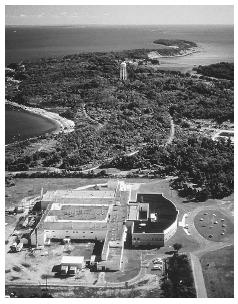Plum Island Animal Disease Center
The Plum Island Animal Disease Center (PIADC), located on a 180-acre site off the northeastern tip of Long Island, New York, is part of the Department of Homeland Security's efforts to protect the United States food supply. PIADC works to protect U.S. consumers and safeguard the integrity of U.S. animal product exports against biologic agents introduced accidentally or deliberately introduced by terrorists.
PIADC scientists protect American livestock by developing methods to identify and isolate foreign animal diseases. PIADC scientists have developed testing, containment, and treatment protocols for a range of foreign animal diseases including foot-and-mouth disease, African swine fever, and African horsesickness. PIADC researchers are specifically responsible for developing a number of antiviral drugs and vaccines for foreign animal diseases and for the development of disease-specific nucleic-acid-based probes that serve in diagnostic tests.
For example, PIADC researchers discovered and developed a synthetic DNA copy of the genetic information contained in the foot-and-mouth disease virus. Further research into the enzyme biochemistry of the virus responsible for foot-and-mouth disease has allowed vaccines to be designed in such a way to enhance vaccine storage. PIADC research also aims to perfect existing vaccines, for example developing enzyme-linked immunosorbent assay (ELISA) tests for foot-and-mouth disease variants that can be used outside the laboratory (i.e., in field tests) because the test does not contain live virus. In standard ELISA tests an enzyme or a radioisotope is covalently linked to the pure antigen or antibody. The unlabeled component, which most often is the antigen, is attached to the surface of a plastic well. The labeled antibody is allowed to bind to the unlabeled antigen. The plastic well is subsequently washed with plenty of buffer that will remove any excess non-bound antibody and

prevent non-specific binding. Antibody binding is measured as the amount of radioactivity retained by the coated wells in radioimmunoassay or as fluorescence emitted by the product of an enzymatic reaction.
PIADC scientists also sequenced (i.e., determined the specific sequence of nucleic acids) the DNA of the African Swine Fever virus, which, as of March 2003, was the largest animal virus ever sequenced. The work at PIADC allowed researchers to compare the genome of the African Swine Fever virus with the genomes of the human immunodeficiency virus (HIV) and human herpesvirus 6. The genomic comparisons provided evidence that the disease (African Swine Fever) was not causally related to either HIV or human herpesvirus 6 infections.
PIADC cooperates with industry to produce livestock vaccines. In addition, PIADC personnel conduct diagnostic investigations for suspected cases of foreign or emerging animal diseases and train veterinarians and other animal health professionals in the diagnosis of foreign animal diseases.
PIADC facilities operate at or above Biosafety Level 3 (BSL-3) standards, and general safety protocols require the use of airlocks, HEPA (High Efficiency Particulate Air) filters, and other specialized vents and filters that remove any virus particles from air leaving the laboratory. Materials leaving laboratories are decontaminated, with waste products incinerated or specially heat-treated to kill viruses. The relative isolation of PIADC's setting and scientific containment facilities allow high confidence in the safety of pathogen storage and testing at PIADC. As of March, 2003, PIADC had never recorded a loss of pathogen containment. PIADC research supports work carried out by the United States Department of Agriculture (USDA) Agricultural Research Service and the USDA Animal and Plant Health Inspection Service.
█ FURTHER READING:
ELECTRONIC:
Plum Island Animal Disease Center. < http://www.ars.usda.gov/plum/index.html > (March 23, 2003).
United States Department of Energy, Office of Science. National Laboratories and User Facilities. < http://www.sc.doe.gov/Sub/Organization/Map/national_labs_and_userfacilit es.htm > (March 23, 2003).
United States Department of Homeland Security. Research & Technology. < http://www.dhs.gov/dhspublic/display?theme=27&content=374 > (March 23, 2003).
SEE ALSO
Argonne National Laboratory
Brookhaven National Laboratory
DOE (United States Department of Energy)
Environmental Measurements Laboratory
Lawrence Berkeley National Laboratory
Lawrence Livermore National Laboratory (LLNL)
Los Alamos National Laboratory
NNSA (United States National Nuclear Security Administration)
Oak Ridge National Laboratory (ORNL)
Pacific Northwest National Laboratory
Sandia National Laboratories
Comment about this article, ask questions, or add new information about this topic: